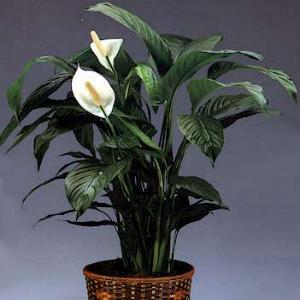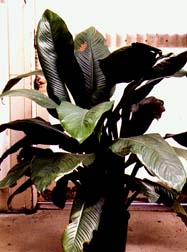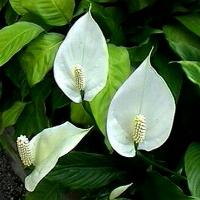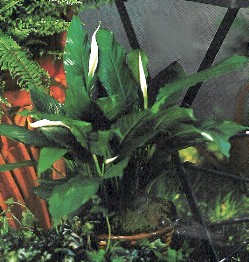|
Plants for your home
(By Mary Efanti)
Spathiphyllum
 Description - Origin Description - Origin
Once more its greek name describes it in detail. Leaves (and flowers) that look like swords
(spathi: sword).
Impressive foliage, relief to the touch, at the end of a thin long branch. Its white
flowers, as impressive, come as the perfect distraction to the dark green
foliage. Both characteristics made spaths very popular to those who love green/foliage plants as well as to those who prefer flowering
plants.
Even though spaths originated in South and Central America (mainly Colombia and
Venezuela) they are today the most popular indoor plant in the U.S. and U.K. In
fact, they are one of the favorite subjects of growers all over the world, so we get new varieties almost every
day, the new plants having more impressive foliage, richer blooming and which are in general hardier than the plants available
today.
Care
It is one of those great plants who adapt easily to different conditions and that's mainly the reason they are so widely used in
homes, offices, restaurants and malls.
Spaths grow not higher but wider as they age. New leaves appear among and around the base of old
leaves, coming straight out of the soil. This is also the criterion to consider when buying a new
plant, as this is a sign of a healthy plant that will develop well.
If you buy spaths for their flowers, choose a plant that has at least one flower in full bloom so that you know exactly what you are
buying. As we mentioned before, there are numerous varieties that differ in both the size and the
color-tone of the flowers.
 Spaths, like most
tropicals, need excellent drainage so the soil should contain peat moss and sand and pebbles should be placed at the bottom of the
pot. Spaths, like most
tropicals, need excellent drainage so the soil should contain peat moss and sand and pebbles should be placed at the bottom of the
pot.
You should water approximately once a week from fall till spring and 2-3 times a week during the summer
months. Before you water, check the surface of the soil which should be dry to the
touch. If the soil is still wet do not water because spaths are very prone to root
rot.
It needs plenty of humidity in its environment but is soil should not be wet for too long and do not let the pot sit in
water. To provide additional humidity place the pot on a pebble tray but make sure it does not stand in
water. If the roots stay wet for even a short period, the tips of the leaves will go
yellow. If however the plant stays wet for more than 5-6 weeks its roots will rot and the plant will
die. Also, if you notice yellow leaves in the center of the plant, you probably overwater so cut down on the
frequency. If on the other hand, the outside leaves turn yellow, your plant is probably getting too much
light.
If the soil goes
dry, the leaves will wilt and hang over the pot. This could happen in as little as 2-3
days, so make sure to water regularly before your plant goes completely dry. When watering a wilted
spath, you should wait for 6-16 hours until the leaves recover. This is of course the lucky
guess, in case you managed to prevent worst from happening. A general indication that the plant needs more water is brown tips on the leaves or the flowers so inspect your plant
often.
Spaths grow well in low light situations. Ideally, it needs plenty of filtered
light, never let the plant in the sun as its leaves will get sun-burned.
These plants do not require much in terms of fertilizing, but you can use some all purpose fertilizer to keep your plant in
shape. Do that once in spring and once in the fall, when the weather cools down a little or you may even fertilize once a month from April to September as long as you use half of the dosage recommended on the
label. Over fertilizing may cause serious or irreparable damage to the root system of these
plants.
In general, spaths love it warm and cold drafts will obviously delay its growth. Low temperatures can damage both the leaves and the root system of the
plant. To avoid that, do not place spaths next to heat producing equipment like radiators or TV sets which will additionally deprive the plant of much needed
humidity.
Ideal temperatures for spaths are between 21-24oC during day and night and temperature fluctuations will harm the
plant. If the temperature is too low, the leaves will fade. If this does not last long the leaves will soon
recover, but if it does last the branches will start to rot. If you expect low
temperatures, move the pot to a warmer location.
 Its flowers are very similar to calla
flowers. They are large, in various tones of white (from snow white to very pale
green) and they appear on top of thin long branches in the same way as the
leaves. In reality, they are not flowers but differentiated leaves that surround a
stemon. These flowers bloom within the first warm months of the year, from early spring until the last warm days of fall and they last for a long
time. When they start to die, cut them back as low to the soil as you can reach. Its flowers are very similar to calla
flowers. They are large, in various tones of white (from snow white to very pale
green) and they appear on top of thin long branches in the same way as the
leaves. In reality, they are not flowers but differentiated leaves that surround a
stemon. These flowers bloom within the first warm months of the year, from early spring until the last warm days of fall and they last for a long
time. When they start to die, cut them back as low to the soil as you can reach.
If your plant fails to produce flowers, cut down on watering and move it to a location where it gets more
light. Plants who get adequate light, even artificial light, will produce more
flowers. Another thing to consider is that spaths like to be a little root-bound in order to produce
flowers.
You can repot in spring, preferably after they produce their first flowers but the new pot should be only one size
bigger. Remember to add pebbles at the bottom of the pot to ensure excellent
drainage. Since spaths grow wider, pots that are wide but not too deep are more
suitable, e.g. dish-pots or any shallow container.
While repotting you can propagate your plant through division of the roots but this should only be done once every 2-3 years so that the root system is not overstressed and it will get enough time to
recover. Make sure to place the plant at the same level of soil as in its original
container.
One of the best advantages spaths have is that they are very resistant to disease and
insects. The number one cause of destroying spaths is overwatering which causes root
rot.
 Clean the leaves as often as you
can, the surface and the underside of leaves, using a sponge and lukewarm water in order to remove dust but also because cleaning the leaves will remove any insects before they become a
problem. Clean the leaves as often as you
can, the surface and the underside of leaves, using a sponge and lukewarm water in order to remove dust but also because cleaning the leaves will remove any insects before they become a
problem.
Another advantage of spaths is that they belong in the NASA list of clean air
plants, since it removes dangerous chemicals from our atmosphere, such as
formaldehyde, benzol, and
carbon monoxide, which are unfortunately present to any house or office.
Good luck with your spathyfyllum!
Mary Efanti
mefanti@otenet.gr
|
